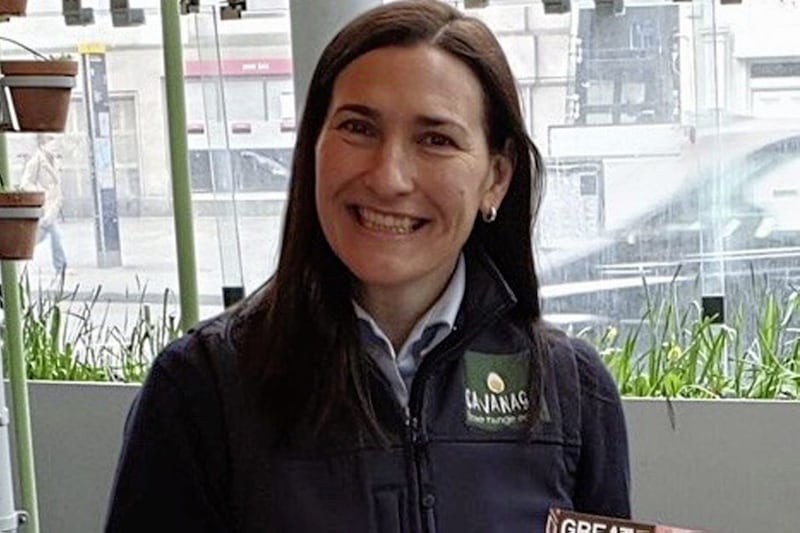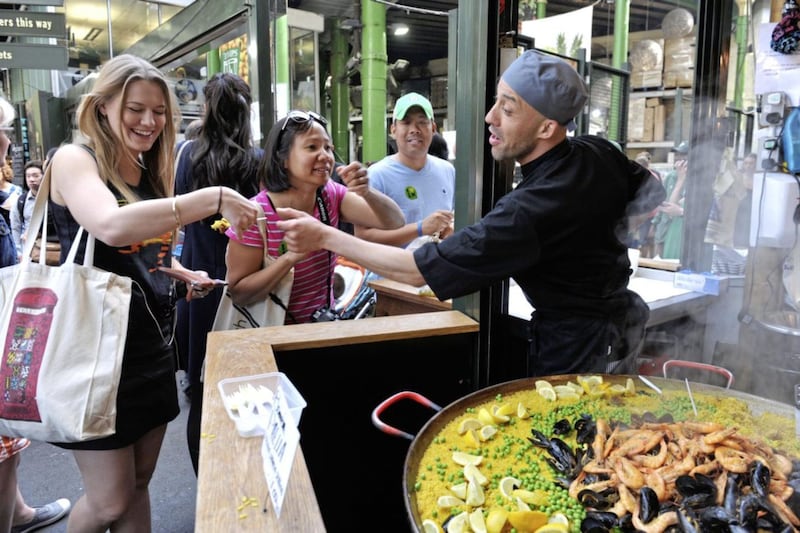BOROUGH Market is arguably the most famous food market in Britain. It sits in the belly of London Bridge, a network of railway arches and overhangs, full of winding pathways, with narrow roads to cross – hopefully without being squashed by delivery vans and crates of cheese – and the smell of baking bread and spices in the air.
Yes, it's the oldest market in London – people have sold produce in one form or another at Borough Market since the 12th century – but in a sense it is representative of any market you'd find in any town: there is food, lots of it, and the producers really know their stuff.
Most recently, Borough has been in the news less for its multicoloured cauliflowers and artisan coffee, and more because of a terror attack on the area in June 3 2017. A vehicle-ramming on London Bridge and a series of stabbings in nearby bars and restaurants in Borough, saw eight people killed, and almost 50 injured.
But food writer Ed Smith, author of the new Borough Market cookbook, a celebration of the producers, stallholders and soul of the market, is clear that, more than a year on, it's business as usual.
The book itself charts a year of shopping and cooking using Borough produce, but its core principles really revolve around seasonal eating – so you can apply the logic – and recipes – to what you find at your own local Sunday farmer's market.
Trained chef and foodie Smith (36), who writes the blog Rocket & Squash, is a former lawyer, turned food writer and trained chef.
Now, he's something of a Borough Market expert and can often be spotted on-site doing cooking demos. We sip on lattes and black coffee from The Colombian Coffee Company and wind our way between traders, nibbling as we go.
Supermarkets are "so sanitised" Smith explains, "You miss out on knowledge, care, expertise..." Take Lizzie Vines, who runs Wild Beef with her husband Richard, an organic Dartmoor farmer. They have a couple of their native Devon cattle and Welsh Blacks butchered every week, hang them for at least another three, and sell the whole animals – nose-to-tail – at Borough.
"We've been here since the beginning," explains Lizzie, who remembers setting up in 1998 when only the original giants of Borough in its current incarnation, Neal's Yard Dairy and Spanish food importers Brindisa, were trading. "There was nowhere to buy coffee after the dawn drive up from Dartmoor," she says – unless you count McDonald's. Fortunately, that's no longer the case.
The practice of selling a whole, single animal, means you can't wander up to Wild Beef and demand to buy five fillet steaks for a dinner party you're hosting – there's only two per cow – it's very much first-come, first-served.
But it encourages thriftiness, working with what's available and understanding what's sustainable. Visiting a market and engaging with stallholders directly, you can't help but get a sense of where your food comes from, and what's gone into getting it to you.
And sustainability is crucial to Borough Market – traders offer recyclable packaging wherever possible, leftover food is distributed to charity, or recycled into power, fertiliser and water at an anaerobic digestion plant. There are always new traders popping up too, with innovative ideas for cutting waste, like nibs etc. run by food waste entrepreneur Chloe Stewart, who makes granola and crackers using leftover juice pulp.
It's also, like many independent food markets, a gateway to slow food – foods that are grown or produced using traditional methods, rather than mass industrial techniques – and to new innovations. For instance, legend has it that Borough grocers Turnips introduced Britain to rocket: "20 years ago it was unheard of," says Smith.
"Yes, it can be more expensive, shopping from independents," concedes Smith, noting that it can require more effort and time than whipping round the supermarket, "but it's undeniably worth it."
:: The Borough Market Cookbook by Ed Smith is published by Hodder & Stoughton, priced £25. Photographs by Issy Croker. Below are three recipes from the book for you to try.
BOROUGH MARKET TOASTIE
(Serves 1)
2 x 1-2cm-thick slices of sourdough
Butter
60g cheese, ideally a 50/50 combination of melting and strong, both coarsely grated
20g sliced cured meat or 40g sliced cooked meat (optional)
15g onions, spring onions or leeks, finely sliced
Condiment of choice (optional)
Method
Butter what will become the external sides of each piece of bread. Build the sandwich, with a sprinkle of cheese on the base first, then onions or the meat, followed by the remaining cheese, then add pickles or spread the condiment onto the inside of the top slice, finally pressing that on top.
Place a heavy-based frying pan over a low-to-medium heat and allow it to warm up for a minute. Transfer the sandwich to the frying pan and cook very gently, regularly pushing down on the sandwich with a fish slice or palette knife. After two minutes, some but not all of the cheese will have melted, and the base of the bread will be browning. Carefully flip the toastie over and repeat the gentle frying and pressing for two minutes more.
Repeat, frying both sides for another two minutes each, so that the cheese and fats are oozing out of the sandwich and the bread is golden and crisp. Remove from the heat and leave to cool for one to two minutes before eating – the centre will be hotter than the sun.
ROAST PLUM PAVLOVA
(Serves 6-8)
For the roast plums:
6 sprigs of tarragon
1kg seasonal plums, halved and de-stoned
40g golden caster sugar
For the meringue:
5 large egg whites (about 175g)
350g caster sugar (or twice the weight of the egg whites)
70g toasted flaked almonds
To finish:
600ml double cream
2tsp vanilla extract
Leaves from 2 sprigs of tarragon
15g toasted flaked almonds
Method
Preheat the oven to 200C fan/220C. Place the tarragon sprigs for the roast plums in the base of a ceramic dish or roasting tin with 150ml water. Lay the plums over these, cut side up. Sprinkle with sugar, macerate for 15 minutes, then bake in the oven for 20-30 minutes, until soft and puffy. Leave to cool for 15 minutes, then transfer the plums, juices and tarragon to a smaller vessel and refrigerate.
Weigh the egg whites. You will need double the quantity of sugar to whites to make a classic meringue, and ideally a stand mixer fitted with the balloon whisk. Set the oven to 130C fan/150C and line a baking sheet with baking parchment or a silicone baking mat.
Ensure mixing bowl is spotless. Add the egg whites and whisk at medium speed until they form stiff peaks. Increase the speed and sprinkle the sugar into the egg whites in a steady stream. Continue whisking for nine minutes, until the mixture is glossy and, if pinched, has no hint of sugary crystals.
Scatter 35g toasted almonds over the meringue mixture. Use a large metal spoon to carefully ripple through the nuts in just two or three large swoops. Spoon the mixture on to the lined baking sheet creating a circle 26-28cm in diameter, with high, wavy sides and an indent for cream and fruit in the middle. Place in the centre of the oven, reduce the oven temperature to 110C fan/130C and bake for two hours, then turn the oven off and leave for one hour more.
Remove meringue from oven and sprinkle 35g of almonds on top. Whip the cream and vanilla extract in a bowl, then spoon on top of the meringue. Arrange the plums and juices over the cream, scatter with fresh tarragon and remaining almonds.
SPICED BUTTERFLIED MACKEREL
(serves 2)
For the pickled carrot salad:
3 carrots (350-400g), peeled and cut into 2mm-thick circles (use a mandoline if you have one)
150ml apple vinegar
70g granulated sugar
10 black peppercorns
1/2tsp sea salt
1tsp yellow mustard seeds
1tsp coriander seeds
Leaves picked from 10 sprigs of coriander
For the mackerel:
2 mackerel, butterflied
1 garlic clove, crushed
Thumb-sized piece of fresh ginger, peeled and finely grated
1tbsp Spice Mountain Mauritius masala (or alternative spice mix – see method)
3tbsp light olive oil
Method
Put the sliced carrots in a container that fits them snugly. Heat the vinegar in a pan with 50ml water to just below a simmer. Add the sugar, peppercorns, salt, mustard and coriander seeds; stir to ensure the sugar has dissolved and pour the mixture over the carrots. Cover and leave to cool for at least one hour, ideally more (up to eight).
Line a baking tray with greaseproof paper. Lay the fish on top, skin side down. Combine the garlic, ginger, masala, oil and a good pinch of salt and spread this over the fish flesh. Refrigerate for one hour. (If you can't find Spice Mountain's Mauritius masala, grind half a teaspoon each of cumin, coriander, yellow mustard seeds and red chilli flakes in a pestle and mortar, and mix with half a teaspoon of ground turmeric and ginger, plus a few turns of a pepper mill.)
Turn the grill on to its hottest setting, set a shelf 6-8cm from the heat source and close the oven door. Allow the oven to heat up for 10 minutes, turn your extraction fan on, then slide in the tray of mackerel and close the door. Grill for six to seven minutes, until the spice mix is sizzling and turning golden and the fish begins to release some of its oils. Remove from the oven and allow to rest for three minutes.
Mix the coriander leaves and pickled carrots (without their pickling juices) and serve alongside the fish.








